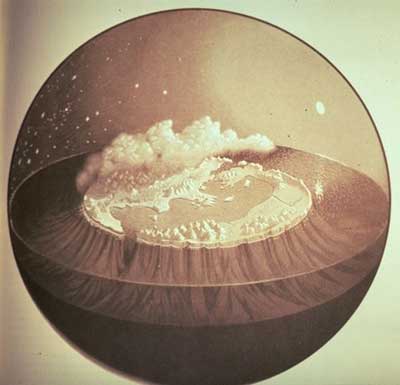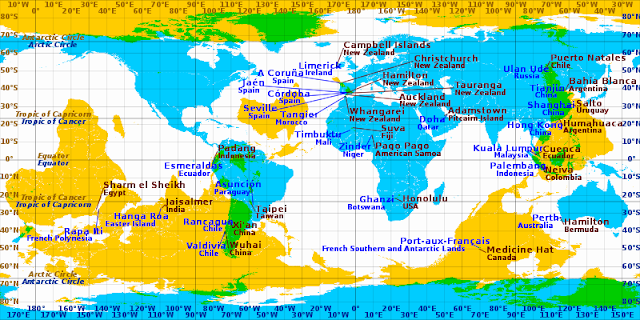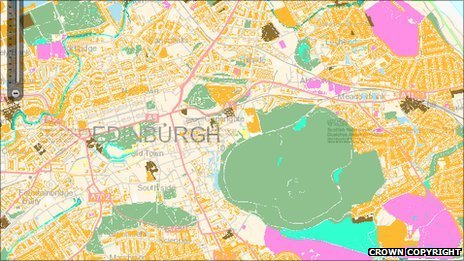This map shows the antipodes of each point on the Earth’s surface – the points where the blue and magenta overlap are land antipodes - most land has its antipodes in the ocean. This map uses the Lambert azimuthal equal area projection. The magenta areas can be considered to be opposite reflections of the blue areas but on the inner ‘surface’ of the globe of the Earth.
The same map, from the perspective of the Western Hemisphere. Here the blue areas can be considered to be opposite reflections of the magenta areas but on the inner ‘surface’ of the globe of the Earth, from http://en.wikipedia.org/wiki/Antipodes
Where is YOUR Antipode?
(and some other cool stuff!)
What’s an antipode, anyway? Some of you geographers may know the term, or you may be familiar with it just from reading the journal “Antipode,” with its subtitle “A Radical Journal of Geography.” Or it’s possible you’ve read the journal but never wondered what the name meant! BTW, if you don’t know about this journal, check out their website at http://www.antipode-online.net/default.asp. “In geography, the antipodes of any place on Earth is its antipodal point; that is, the region on the Earth's surface which is diametrically opposite to it. Two points which are antipodal to one another are connected by a straight line through the centre of the Earth.” From
http://www.antipodemap.com/ A
line drawn from one place to its antipode passes through the center of the Earth and forms a true diameter.

I really enjoy saying “Antipode,” (pronounced `an-tep-ode, with the emphasis on the first syllable) but even more, I love saying its plural “Antipodes,” (pronounced an-`tip-o-deez, with the accent on the second syllable). The word derives from the Greek words for “opposed” (anti-) and “foot” (pod or pous), or under the feet, opposite. Later on, the Latin usage changed its meaning to “those with feet opposite,” a race of people with feet sticking out of their heads, or people who were inverted and walked on their hands with their legs sticking up in the air, which is what the population on the other side of the world was imagined to be doing. These were common mythical creatures that mediaeval map makers often drew in unknown places to fill up the space. These up-side-down people living at the opposite side of the earth were known as Antichthones, another great word! They took their place on mediaeval maps and marginalia right next to the dog-faced race and the sciapods! "Yonder in Ethiopia are the Antipodes, men that have their feet against our feet." (from the earliest usage in English of the word "Antipodes," from a 1398 translation of Bartholomew of England's "The Properties of Things," a kind of proto-encyclopeadia in 19 volumes written in Latin in 1240).

An interesting thing about the antipodes is that the concept was recognized by the ancient Greeks, (Plato, Aristotle, Plutarch, Strabo, and Diogenes) demonstrating their understanding of a spherical world. In contrast, the early Christians found the idea of antipodes to be absurd, requiring a belief that people in the antipodes were inverted, because, of course, being on the other side of the world and all, they couldn’t possibly stand on their feet like we do! Popes and clergy declared the very notion of antipodes to be heretical, because it would require a belief that, since all people descended from Adam and Eve, descendants of Adam and Eve would have had to have gotten in a boat and traveled over seas to the southern lands, (which were not even known in those times with any certainty to exist). From the point of view of scriptural inerrancy, the fact that the Bible doesn't mention anything about this at all means that it could not be possible.
As a digressive aside, if you are interested in sciapods and other mediaeval beasts, or mediaeval topics in general, pick up a copy of the 2003 book "Baudolino," which tells a fabulous tale involving Prester John (the lost Christian king of the East) and touches upon all the major themes of the day (early 12th century Constantinople): The Fourth Crusade; the troubadours; the legend of the Holy Grail; the rise of the cathedral cities; the position of Jews; the market in relics; the local rivalries that made Italy so vulnerable to outside attack; the perennial power struggles between the pope and the emperor, and the geographic location of the Earthly Paradise. One of the main characters is a sciapod! This mythical epic story is by Umberto Eco, of "Foucault's Pendulum" and "The Name of the Rose" fame. All of them are worth reading.
Back to the Antipodes: By going to the website
http://www.antipodemap.com/ you can click on your location on the top map, and the bottom map will show you your antipode. Pretty cool.
Although it seems strange that our antipode is an iceberg in the middle of an ocean, actually it is about what we would expect. After all, over 70% of the earth’s surface is covered by ocean, and the land masses of the southern hemisphere are particularly skimpy. So the antipode of just about anywhere in the northern hemisphere is likely to be in the middle of the ocean. Less than 4% of the earth’s land masses are antipodal to land.
The way you can calculate your antipodal location by lat-long is to figure that the latitude will be identical, except with the direction reversed. For example, the latitude of the antipode of 40o N will be 40o S. The antipodal longitude will be 180o difference between the two points, with reversed direction, resulting in a location at 74o W having an antipode at 106o E.
x° N/S y° E/W ↦ x° S/N (180 − y)° W/E
Noon at a location is midnight at its antipode, and summer solstice is winter solstice
Some cities and towns which are near-antipodes in equirectangular projection. Blue labels pertain to cyan and brown labels pertain to yellow areas. Areas where cyan and yellow overlap (coloured green) are land antipodes.
Find your Center of Gravity
In a similar vein, here is another cool website sent to me by Ms. Grady. With this one, you plug in all the places you have ever lived, and the program calculates the geographical center of all your residences, weighted by number of years or months spent there. You can also do it without weighting it by time. It’s really interesting. I entered all my addresses (if you don’t remember the exact street address, you can just put in city and state), every place I could remember where I spent more than about 2 months of my life. Anywhere I had a “room of my own,” in other words. With all the different places I’ve spent significant time, when I weighted it by years, my center of gravity ended up being along the Old Montauk Highway, Suffolk County, Long Island (NY). This is primarily due to the overwhelming number of years I spent at various addresses in NYC, which pretty much cancels out any years spent anywhere else. I never even lived in Long Island (not that there's anything wrong with it!) When I entered the same addresses without the time weighting, my center of gravity was way up in Maine, for some odd reason!
http://www.geomidpoint.com/
The “What Was There” Project
This one is from Lesley Kunikis. Check it out! Some pretty cool stuff!
“Thought this might be of interest to you: http://whatwasthere.com/ The What Was There project was inspired by the realization that we could leverage technology and the connections it facilitates to provide a new human experience of time and space – a virtual time machine of sorts that allows users to navigate familiar streets as they appeared in the past. The premise is simple: provide a platform where anyone can easily upload a photograph with two straightforward tags to provide context: Location and Year. If enough people upload enough photographs in enough places, together we will weave together a photographic history of the world (or at least any place covered by Google Maps). So wherever you are in the world, take a moment to upload a photograph and contribute to history!”
Manhattan on vacation in Chicago
Manhattan travels to other cities...
Scale Comparisons by Bill Rankin. “Inspired a bit by Rem Koolhaas’s Floating Pool project, I wondered what would happen if Manhattan itself decided to take a tour of the oceans, stopping at other cities to refuel and have a good time. Overwhelmed by LA’s vastness, Manhattan decides to stay offshore, while it snuggles in close and completely overwhelms Boston (and inadvertently obliterated Logan Airport).” (From Radical Cartography, Bill Rankin’s website). See Manhattan nestling up to various other cities. So cute!
New York's Bike Requests as a Map of the City's Yuppies
This is about NYC’s new bike sharing program, and apparently the 600 or so bike locations are being decided by web voting. The only problem with this is that the less affluent parts of the city seem to not be voting with the fervor of the more gentrified and yuppified sections, or, dare I say it, those populated by the dreaded hipster. This seeming lack of interest from the less affluent sections of the city denotes, perhaps, less Internet access, less interest in biking, or less disposable money to pay for the yearly bike sharing license.
A detail of the previous version of New York City’s subway map, left, and this year’s simplified edition.
A Village Street Slips off the Subway Map This one is from Cordelia Nervi.































